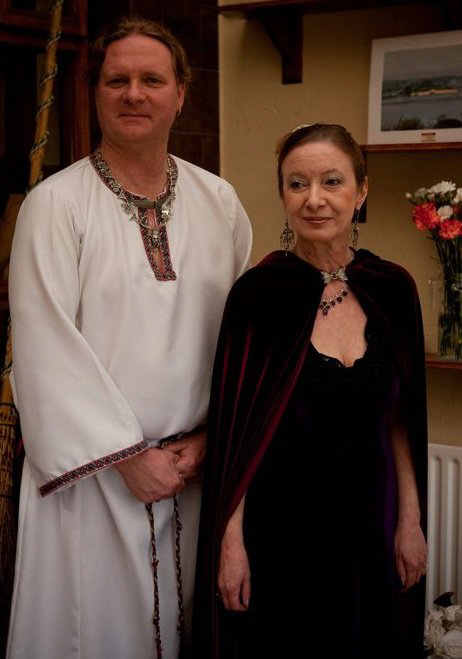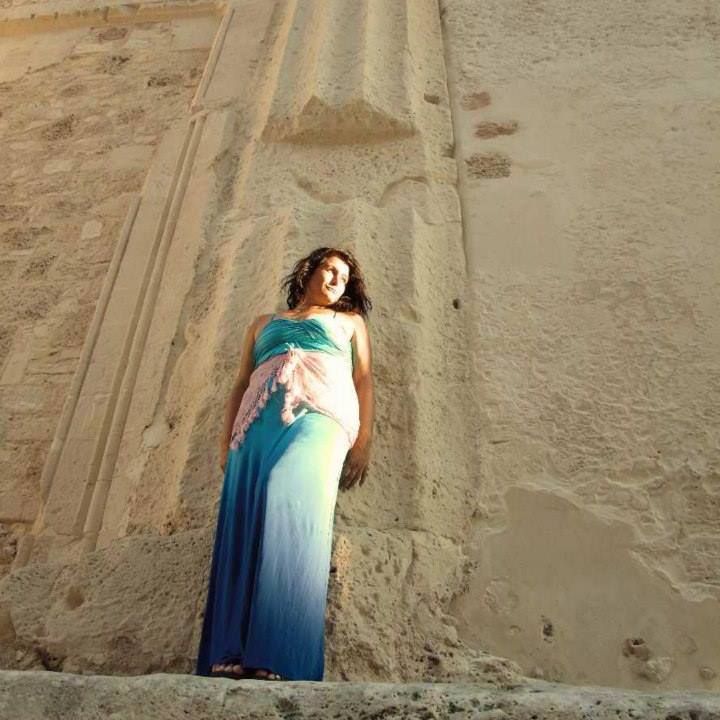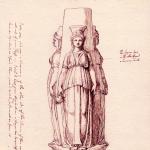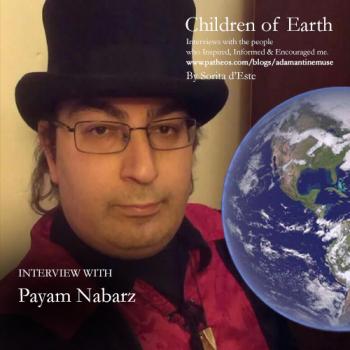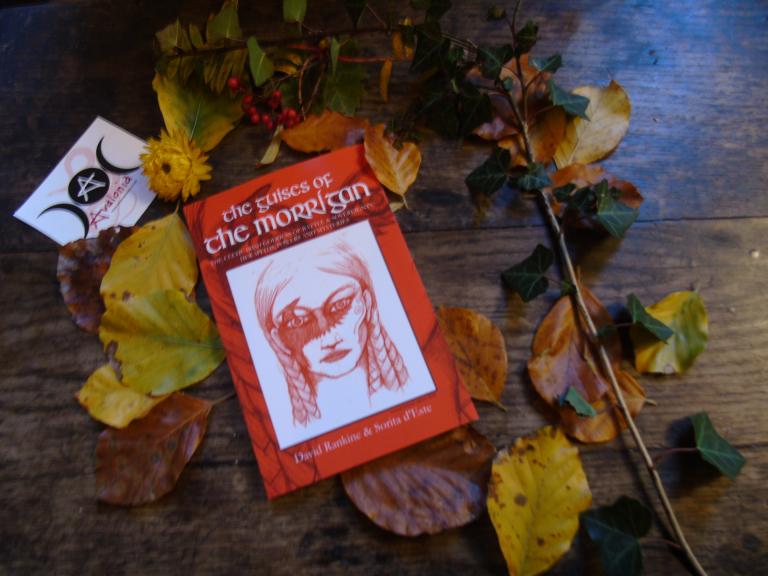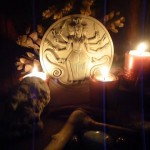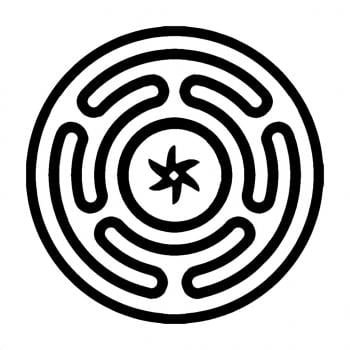Janet Farrar and Gavin Bone really should need no introduction here. Janet’s work with the late Stewart Farrar was long the cornerstone works for newcomers to Wicca, Witchcraft and other Pagan Traditions. They influenced an entire generation, and I would go as far to say (my words, not theirs!) that much of the explosion in Pagan and Goddess traditions during the 80s and 90s would not have been possible without the influence and changes their works introduced. We might look at books like the Witches Bible today and say “its the same as everything else“, but that is because the everything else we perceive as being the same was inspired and informed by the work they published. In a nutshell, if you started your journey towards whichever Pagan or Goddess tradition you are involved with after the 1970’s it is very likely that your work has been influenced in one way or another by the work Janet and Stewart produced.
After Stewart’s death in 2000, Janet and Gavin continued teaching and writing about the Craft and the work they continue to produce today are based on a staggering 80+ years experience between the two of them! Their work continues to influence and shape the next generation of practitioners of Witchcraft.
I asked them about their own influences, and about their work with Trance Prophesy, their book Lifting the Veil and many other things. Gavin reveals a very witty sense of humour in the Trivialities questions at the end too. Please comment and share if you enjoy.
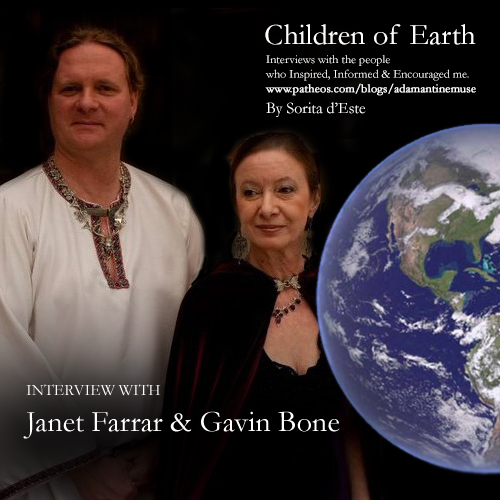
Sorita d’Este interviews Janet Farrar & Gavin Bone
Children of Earth: People who Inspired, Informed or Encouraged me.
Sorita d’Este– It is a privilege to be including you in this series of interviews, your combined experience within Pagan traditions and Craft practices and the dedication with which you have continuously practised and shared your work is phenomenal. I imagine that Witchcraft and Paganism in the 21st century must seem different in a million ways from how things were when you both first started out on your respective journeys in the Craft. What would you say the primary differences are today?
Janet Farrar & Gavin Bone – I (Janet) came into the Craft, as most people know in the early 1970s. But even since Gavin came in, in the early 1980’s it has changed considerably. The major difference has been the level of tolerance and openness which has occurred. Back in the ’70’s, it was a case of ‘never the twain shall meet’ when it came to the two main traditions, Alexandrian and Gardnerian, and if you weren’t part of one of those traditions you were often told that you weren’t ‘a real witch’, or worse! Gavin experienced this in the 1980s as it was still the case until major changes later occurred at the end of that decade.
Of course, there was also intolerance towards members of the Gay community and few covens, certainly in the UK initiated openly gay or lesbian members. We (Stewart and myself) were the first to do so in Ireland in the early 1980s, but we were the exception. The other major thing that has changed, which has pushed the pagan movement forward has been communication. People forget that the internet didn’t appear before the early ’90s, so communication was limited between covens and groups, and people relied on word of mouth plus a few periodicals such as The Wiccan. It was common for people to meet up with others at publicly open non-pagan events such as The Prediction Festival in London to find out what was going on. The 1990s and the rise of the internet changed everything allowing public debate in the pagan community and a change in attitudes for the positive in the community as a whole.
Sorita d’Este – We first met at a witchcraft conference in Croydon near London in 2003 (4?). It was an event attended by thousands of people interested in Witchcraft, Wicca and Paganism from around the world; and one of many such events over recent decades. Festivals and conferences such as this offer talks and workshops, and the opportunity to participate in “open rituals”. Some of our contemporaries in Initiatory Craft feels that the Craft should be more secret, and others that the information and practices should be open to all. What are your feelings on secrecy in the Craft, and has your opinion changed as you gained in experience over the years?
Janet Farrar & Gavin Bone – To really answer that question we really need to look at the origins of secrecy in Wicca.
In the 1940s and ’50s in England, identifying yourself as a ‘witch’ could still get you into trouble. The oath, the keeping of secrets became important purely for protection. Of course, cultural changes in the 1960s meant many witches started to become more open about who they were- if it was safe to do so where they lived. This is still the case; if you happened to live in the USA in Northern California you could be pretty open about who you were. The positive effects of this are that people find out who you really are, and it helps put the stereotypes to rest. But if you live in the Bible Belt, such as Alabama, then you need to keep your head down as you could still end up losing your job.
There were also other problems with secrecy apart from how the Craft interacted with the larger community. Secret covens with oaths where its members weren’t allowed communication with other members of the Craft, were open to abuse and manipulation occurring, particularly of a sexual nature. Members simply did not know what was and wasn’t acceptable within the Craft, or for that matter you often had coven’s claiming origins which simply weren’t true. Of course, such groups were in the minority. Once things opened up in the late ’80s and ’90s it became more and more difficult for such groups to function. There is also the subject of the material of the Craft; The Book of Shadows (BOS). People just accepted all of it was ancient and therefore oathbound for that reason.
Once public copies began to circulate, people began to research its origins and realised nearly all of it was from the literature of the time, or from other traditions. A good example of this is that people used to state that Crowley had nothing to do with Wicca, but now we know quite a bit of his material was in the BOS, and of course, once Gardnerians and Alexandrians started to compare their BOS’ in the 1980’s they realised they had more in common than they thought and communication and co-operation started to occur between them.
We strongly believe the real secrets of the Craft are those that happen between the Craft; not the tradition but the members. Quite simply what happens in a coven is private unless it is abusive in some form, as a coven acts like a psychotherapy group if it is working properly. The rituals and training practised are really not really anyone else’s business; strangely there are quite a few traditional covens, particularly in the US that seem to think that they have the right to see what is going on in their sister covens. They don’t; once a hive off has occurred that coven is independent. This should be the real focus of the oath, to protect the Craft; the privacy and security of the coven members, not to protect pseudo-archaic material.
Sorita d’Este – You are both well-known authors and teachers of the Craft with a great deal of experience between you. What advice would you offer people reading this who are thinking of starting their own group or teaching in another capacity?
Janet Farrar & Gavin Bone – Urrh, are you a masochist? It is hard work, with emotional ups and downs; both laughter and tears. For it to work you have to be pure in your reasons to do it, you must be free from ego and the most important thing to remember is this, you have to accept you don’t know everything. We are now coming up to 80 years of experience between us, and the one thing we have realized is that we have only touched the tip of the Iceberg regarding how much we know. Be honest about what you don’t know, be willing to say ‘I don’t know, but I will find out!’ Also, be aware of this, work with the gods. Something else we have learnt. When you take an oath to serve the gods, accept that. If you work with them positively that’s fine, but if you don’t; If you are led by your ego, then they will use you to teach the hard lessons to people.
Sorita d’Este – I am, in part, interviewing you because Janet’s published work (with Stewart Farrar) influenced the younger me, as it did many others. Who inspired you on your own respective journeys, and how does that inspiration live on today?
Janet Farrar & Gavin Bone – We can both agree that Doreen Valiente was a major influence for both of us. For Gavin, hers were the first books on modern witchcraft that he read; ABC of Witchcraft. This book and those that followed made him realise that he was practising witchcraft, as at the time he had no name for it. For Janet, it was when she co-operated with her and Stewart during the writing of Eight Sabbats for Witches (A Witches Bible). She didn’t care what tradition what Janet and Stewart’s were, for her they were both witches, and that was all that was important. Janet always admired her down to earth attitudes and they remained good friends for the rest of her life.
Sorita d’Este – Over the years I have heard some Wiccan Elders claim that mystical experience is not so important in Wicca, and that tradition and community is more significant and maybe even more desirable. Personally, I put an emphasis on the idea that the Craft is about Magic, Mysticism and Spirituality (Religion). Tradition for me is something to learn from and evolve as you gain in knowledge and experience, not something to follow slavishly. How important is tradition and mystical experience in the way you teach the Craft?
Janet Farrar & Gavin Bone – At the moment we’re biting our tongues and trying to come up with a diplomatic reply to this question. We think you have to have had the mystical experience; the experience of Gnosis to understand how important it is in the Craft. One of the most basic statements made is The First Thing Magic Changes Is The Self. We find it sad that people don’t seem to understand what this means. This hasn’t always been the case, both Gerald Gardner and Alex Sanders understood the importance of the mystical connection in relation to witchcraft. This is very clear from the material both put into the BOS.
Gardner is also well known for fast-tracking one well known HP for initiation because of the mystical initiatory experience he had clearly been through. If you work with magical energy; prana or whatever else you want to call it, it changes you, it pushes out things you have repressed and not dealt with. This clears the way for you to have such an experience with the divine in some form. You’re focused changes, it ceases to be primarily about the magic and becomes about the connection to the divine; perhaps a specific god or goddess, and becomes about service to them. This is the true meaning of Priestess or Priest. Magic then just becomes a tool to do the job, and an act of service or even worship to them.
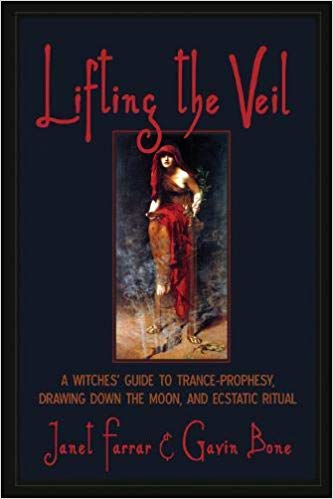
Sorita d’Este – Your book Lifting the Veil was published in 2016, but I know it was a project you worked on for many years. Back in 2008 you contributed an essay to an anthology I edited, Priestesses, Pythonesses & Sibyls, in which you detail some of your ideas on Trance Prophesy and revealed that you were working on the book. It might have been only a little more than a decade ago, but back then there was very little written on the topic, and as I was myself heavily involved in using different forms of trance for oracular and other work in the preceding years,so doing the anthology was an opportunity for me to learn from some of the most interesting practitioners at the time.
Lifting the Veil is specifically aimed at witches and looks at not just trance prophesy, but also the Wiccan practice of Drawing Down the Moon and ecstatic ritual. Why do you feel that trance prophesy is important within contemporary Paganism and Witchcraft?
Janet Farrar & Gavin Bone – There are several reasons we consider it important. Initially, we started doing this work to fill in the gaps in training in Drawing Down the Moon, which we consider to be the most important ritual in Wicca. It is the centerpiece where divinity; a goddess, should direct spiritually direct the work of the coven. The results of directly working with divinity resulted in this work quickly becoming about channelling deities and then ultimately being possessed by them, both in oracular and ecstatic work. It was during this that we discovered why this work is important.
We discovered that it wasn’t so much about prophecy, but more about divine direction. What we started to get from the different deities was warnings about the changes the work is going through, both ecologically and politically. In most cases, they were giving a call to action. Of course, we shouldn’t be surprised at this, as in human history the oracles appear in cycles; at times of environmental, sociological and cultural stress. You see this clearly occurring with the appearance of the Sybils whose oracles circled the Mediterranean (1000-100 BCE) and later in the Dark Ages with the Norse Valas (300-1000 CE). They begin to reappear in this era shortly after the American Civil War as Spiritual Mediumship, reappearing again during the First and Second World Wars. It is no coincidence that Wicca, which incorporated Drawing Down the Moon, a form of oracular ritual appears at this time. We now again face environmental, social and political stress, so yet again the oracles appear to allow the divine to warn us and guide us. For this reason, we consider it some of the most important work we have ever done, as its purpose is to influence mankind and direct us to make the right decisions.
This is best summed up by an oracular session done by one of our initiates in 2013 when she was possessed by Hekate:
“You are skating on thin, thin ice… Whether that ice cracks is up to you. This planet will survive; it always does. The gods will survive; we always do. Some of us may sleep while some of us are more active. The world is on thin ice, but all hope is not lost. I feel the ice strengthening. The not too past, the not too… oh the words… the ice was once thinner. But as you all start to wake up, wake up to this change of paradigm, this change of humanity, as the old ways go through their death throes and grasp as power, the ice thickens. Do not be afraid when it cracks. It can be repaired. It’s in your hands.”
Sorita d’Este – In Lifting the Veil you discuss trance techniques from a variety of traditions, including the Norse tradition of Seidr, and also African Diaspora traditions such as Vodoun, Candomble and Santeria. You mention the trend for contemporary Pagans to incorporate aspects of these traditions into their own practices. Based on your own research and experience, what would you say the primary benefits are for Neo-Pagans to incorporate trance techniques from these traditions?
Janet Farrar & Gavin Bone – We learnt a lot in the ’90s and early 2000s from being invited to genuine Vodoun and Santeria rituals. What we took away was an understanding of how their trance traditions worked; the techniques involved, the most important one being is that they did not use just one technique, but several combined. It’s also important to point out that there is a difference between tradition and technique; between creating a Veve to Oshun and using the same method to create a specific European symbol in to invoke one of our own native gods or goddesses.
Another thing we learned from contemporary traditions, and this was not just restricted to African Diaspora was that the techniques they use and those of ancient Europe weren’t really any different. An excellent example of this would be the ecstatic ritual that took place at Delphi prior to the Apollonian Priesthood, where the Sybils were involved in an ecstatic ritual which incorporated many of the same techniques you find in Vodoun and Santeria; singing, dancing, and drumming.
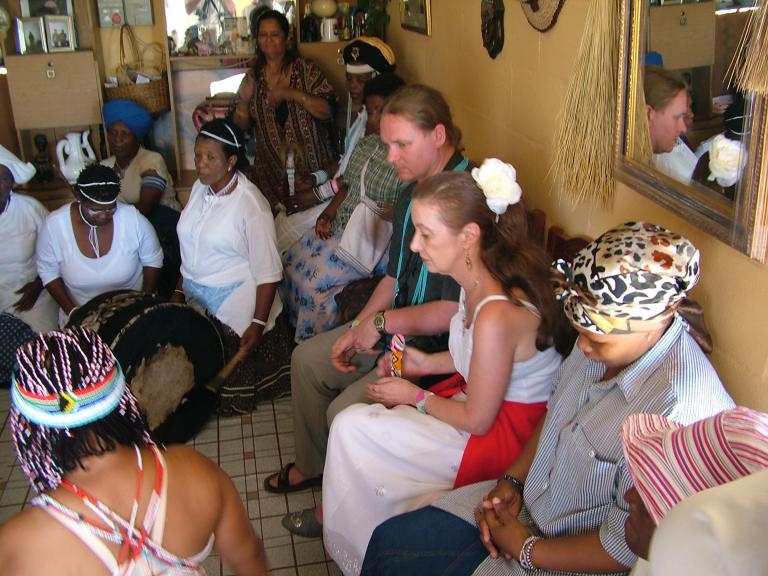
Sorita d’Este – What would you say to people who feel that mixing the practices of neo-Paganism with the trance practices and customs of the African diaspora traditions is at best foolish and at worse dangerous?
Janet Farrar & Gavin Bone – We think you will be surprised by our answer because actually, we would agree. although we don’t apply Don’t mix traditions as a blanket term, as you can see in the ancient world that the Classical cultures absorbed other magical traditions all the time without a problem, a good example is the latter Graeco-Egyptian Mystery Schools. What is important is whether traditions are compatible with each other.
African Diaspora Traditions aren’t for two important reasons. The first is about respect for other cultures. It is misappropriation and disrespectful to the peoples of these traditions to mix them with European, and secondly, there are potential magical dangers. These are potent traditions, their ‘deities’; their spirits are incredibly strong and very demanding. Ours are nowhere near that level of power yet where they are able to manifest at the same level. It is one of the reasons we started this work on Trance-Prophesy and Possession work, as we saw people of European background getting attracted to these traditions because they seemed to offer an instant mystical experience, and they often weren’t interested in the tradition itself. This was fine if they had experience of, or were of a Caribbean background; Hispanic or African, they understood the cultural nuances and had training in one of the houses that exist. But if they had no knowledge, they often got ‘burnt’ as a result, something we witnessed several times. There’s nothing worse than watching a Loa or Orisha turning someone’s life upside down because they didn’t understand the level of commitment they had to make. We wanted the opportunity to fill this gap in neo- paganismthat existed and prevent this from happening.
Sorita d’Este – Most people reading this will know that you live in Ireland, which is widely considered to be a very magical landscape – filled with stories of faeries and Gods. For those reading this who are thinking of visiting Ireland, which places would you recommend they put on their must-see lists and why?
Janet Farrar & Gavin Bone – There are so many places. Gavin used to do mystical tours of many of these sites; he trained early on with an earth magician as a dowser. The energy at these sites is incredibly strong, as anyone who has been to any of them will tell you. Newgrange (Bru Na Boinne), and Knowth are the largest chambered tombs in Ireland, and although very touristy now are a must to visit. Of the two Knowth is our favourite as it has very feminine goddess energy as opposed to Newgrange. Slieve Na Callaighe (Hill of the Witch) is less than 20 minutes from where we live in Kells. We have a strong connection with this site. It’s the connection point for our covens both in Ireland (Teampal Na Callaighe) and in Italy (Tempio Di Callaighe), and our other initiates in Europe and the US. All these sites we’ve mentioned so far have the most amazing decorated stones, notably Cairn T on Slieve na Callaighe. All of these sites are over 5,000 years old. Other locations include Tara; the home of the High Kings. A site whose history is entwined with the ancient history, politics and religion of Ireland.

Sorita d’Este – How do you think Wicca and Goddess Spirituality will change and evolve over the next twenty years?
Janet Farrar & Gavin Bone – Without any doubt, in the current climate, it will get more political and involved in direct action. In the past, it was generally said that we should not collectively get involved in politics, but it may well be necessary for survival. We are facing the reappearance of persecution of ALL minority religious groupings from evangelical Christianity, the erosion of women’s rights, as well our traditions being co-opted by the Alt-Right. More importantly, we cannot sit on the fence regarding the environment. The reality is this swing towards political action by pagan groups is already happening, and it’s going to grow, it must. There is still room for the mystery traditions, and the covens which need to remain secret, as well as the establishment of legal pagan churches. There are rooms for all. This will always remain. People need to realise that we are here for a reason, and that is to make a change in the world; that has been the focus of our work in Trance-Prophesy as we have previously mentioned.
Trivialities
- Your favourite book of all time? Janet: Impossible to answer! There are so many books I love. Gavin: Has to be The Way of Wyrd by Brian Bates.
- Your favourite character from history? Janet: Countess Bathory (she was innocent!). A relative through my Huguenot blood! Gavin: Hmm, Claus Von Stauffenberg.
- Your favourite element? Gavin: Oxygen, I don’t know what I’d do without it, but I do like most of those in Group 11 of the Periodic Table . Janet: All of them.
- Your favourite food? Gavin: Vegetarian Lasagne. Janet: A properly made Curry!
- Your favourite number? Gavin: 42 Janet: None I can think of.
- Your favourite planet? Gavin: Pluto; I love any planet which has an identity crisis. Janet: Earth
- Your favourite plant? Gavin: Robert Janet: Lillies, Rose, Lilacs, Primrose, so many!
- Your favourite stone? Gavin: Mick Jagger. Janet: Amethyst, no Opals, no Emeralds!
- Your favourite Tarot / Oracle deck? Gavin: I actually work with Anglo-Saxon (Ruthwell) Futhork. Janet: The Classic original Rider-Waite. Still have my original one from the seventies which I still use regularly.
- Your sunsign? Gavin: Capricorn, with triple Pisces (Ascendant, Venus, and Moon), which explains my rather weird sense of humour. Janet: Cancer (Ascendant in Libra, Moon in Scorpio).
Thank you so much for doing this interview Janet & Gavin, I believe that many will benefit from the insights you share – now and into the future.
I really meant it in the introduction that Janet & Gavin needs no introduction, at least not to those who are well read and informed about the history of Wicca in the 20th century and Paganism today. But, if you are new to Pagan traditions, or perhaps from the new generation, it is possible that you have not encountered their work and that this is your introduction. For this reason I include this biography, to act as an overview of their important contribution to modern Paganism and Wicca.
Who is Janet Farrar & Gavin Bone
With her late husband, Stewart Farrar has written over a dozen books on the Craft to date. Titles which include Eight Sabbats For Witches’, The Witches’ Way (one of the first books to suggest the southern hemisphere turn for festivals in Australia), The Witches’ Goddess, The Witches God, Spells and How They Work. Janet has also had one book published jointly with Virginia Russel, The Magical History of the Horse, and with her current partner Gavin Bone, three books; The Pagan Path, The Healing Craft, The Dictionary of European Gods and Goddesses, Inner Mysteries, and their latest work Lifting the Veil. Their books have become some of the most influential in Witchcraft and have set the mould for modern Craft writers worldwide. At home in Ireland, while Janet works as a professional Tarot Reader, Gavin also works as a natural empathic Spiritual Healer. Both have specialised in recent years in trance-prophesy and possession work.
Since her initial introduction to the Alexandrian Craft with Stewart, Janet with Gavin Bone has developed her own unique brand of Witchcraft and both have been given honorary initiations into several other traditions, including traditional Italian Strega, and into the Lesotho Sangoma (traditional healers) of South Africa. She prefers just to be called witch rather than any specific tradition. In 1999 both became ordained as third level Clergy with The Aquarian Tabernacle Church. They also founded the Tempio di Callaighe in Italy. Gavin also works as an Adjunct Professor in the US-based Woolston-Steen Seminary teaching Progressive Witchcraft and Runic studies.
Both Janet and Gavin tour regularly doing intensive workshops in the United States and Europe, as well as Australia, New Zealand and South Africa. They believe strongly in the idea of witchcraft being both progressive and dynamic in nature, while remaining a clergy of those dedicated to serving the Gods and Goddesses. They are responsible for setting up several progressive covens in the United States, United Kingdom and Europe.
